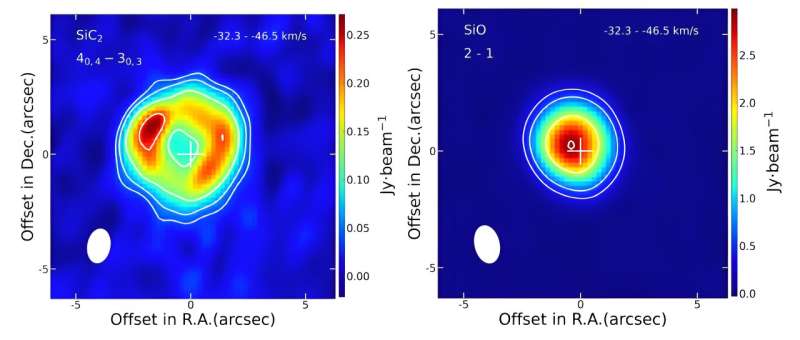This article has been reviewed according to Science X's editorial process and policies. Editors have highlighted the following attributes while ensuring the content's credibility:
fact-checked
preprint
trusted source
proofread
Annular distribution of SiC2 in circumstellar envelopes of carbon-rich asymptotic giant branch stars

The circumstellar envelopes (CSE) of asymptotic giant branch (AGB) stars contain a large number of molecules, which account for about one-third of all molecules discovered in interstellar space.
Gas and dust are essential components of CSEs, and SiC2 is one of the significant constituents of dust grains in carbon-rich AGB stars. Whether SiC2 is a "parent" molecule formed in the photosphere or during the high-temperature dust formation process (exhibiting a "solid" spatial distribution), or a "daughter" molecule formed through photodissociation of "parent" molecules in the outer envelopes (exhibiting an annular distribution), is an ongoing debate.
Researchers led by Ph.D. candidate Feng Yanan and Prof. Li Xiaohu from the Xinjiang Astronomical Observatory (XAO) of the Chinese Academy of Sciences have conducted observational work on the SiC2 molecule in circumstellar envelopes of three carbon-rich AGB stars (AI Vol, II Lup, and RAFGL 4211) using the Atacama Large Millimeter/Submillimeter Array (ALMA).
Their study was published in Frontiers in Astronomy and Space Sciences on Aug. 14.
They found that the spatial distribution of the four rotational transition spectral lines of SiC2 molecules around these three sources exhibited an annular distribution, indicating the feature of a typical "daughter" species.
Then they compared the ALMA results of SiC2 and SiO molecules in AI Vol. The SiO molecule exhibited a "solid" distribution feature, indicating that it is a "parent" molecule, which is consistent with previous studies.
"In future studies, we need to rethink the formation mechanism of SiC2 in the CSEs of evolved stars," said Prof. Li.
More information: Yanan Feng et al, Photochemical origin of SiC2 in the circumstellar envelope of carbon-rich AGB stars revealed by ALMA, Frontiers in Astronomy and Space Sciences (2023). DOI: 10.3389/fspas.2023.1215642
Journal information: arXiv
Provided by Chinese Academy of Sciences



















